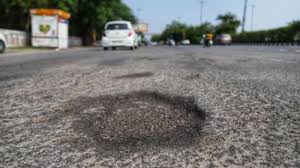Click here to join Express Pune WhatsApp channel and get a curated list of our stories
‘Running out of road in Pune’: From metro debris to potholed stretches, streets are becoming unsafe for runners in the city
Runners from across Pune used to come to Pashan, but now prefer safer pockets, such as Savitribai Phule Pune University, housing complexes in Magarpatta, and other areas on the outskirts and Sinhagad Road.
 Prasad Patil, a runner who has motivated and coached a number of amateurs to find their stride in urban spaces, says that there is no comfort for a road runner in Pune any longer. (File photo)
Prasad Patil, a runner who has motivated and coached a number of amateurs to find their stride in urban spaces, says that there is no comfort for a road runner in Pune any longer. (File photo)Dr Neelam Vaid, an ENT specialist, had been running on the road for more than 15 years in January 2025, when she had a fall on Baner Road, parts of which were broken due to the metro construction. Vaid fractured her fingers and was in a cast for quite some time. After the accident, a kind of fear set in that had not existed in her mind before.
Vaid used to be a solo runner and has finished ultra marathons (races of more than 42.195 km). But today, she looks for someone to run with, or runs with a mobile. “There was a time when I would run alone, setting out around 4 am. I never felt any insecurity. Now, I can only run once the sun is a little up. So, I go out for my run much later. I no longer feel comfortable running on roads because their quality has deteriorated. There is this element of fear, a feeling that anything can happen to me on the road and I might need to reach out to someone,” she says.
Pune, historically famous as a city of cyclists, has also been a haven for runners. Innumerable running groups have risen on the city’s tree-lined roads that were wide and safe. Veteran marathoners of Pune have won accolades across the world. The city’s calendar is packed with cause-driven marathons and half-marathons, from the College of Military Engineering (CME) Pune’s ‘Soldierathon’, dedicated to Indian soldiers, which will take place on November 9, 2025, to the Pune International Marathon 2025, considered to be India’s first marathon, whose 39th edition will be held on December 7, 2025, to Vrukshathon, a summer half-marathon that aims to spread environmental consciousness.
Hitting a rough patch
Prasad Patil, a runner who has motivated and coached a number of amateurs to find their stride in urban spaces, says that there is no comfort for a road runner in Pune any longer. “We used to go running 10-15 km one-way. Today, it is a challenge to find even two to three km of straight road with a clean environment,” says Patil. He lists the problems – from the population growth in the city since COVID-19 to the traffic rush that begins very early, to the potholed roads, broken pavements, and construction debris and other material that lie around the streets. “Development work goes on constantly. It is common for us to, one day, find a road dug up for the metro or a pipeline or internet cabling, and not repaired for a long time,” he says.
Runners from across Pune used to come to Pashan, but now prefer safer pockets, such as Savitribai Phule Pune University, housing complexes in Magarpatta, and other areas on the outskirts and Sinhagad Road. SB Road and the Aundh-Baner Road were popular with runners. “I don’t go to Aundh-Baner Road anymore because it is littered and filthy. What I also notice is that the growth in the number of new runners has reduced. Organically, there should have been a 15-20 per cent growth in my group. When new people join, they go outside the city to run,” says Patil.
His fellow runner, Dr Jitendra Walture, who has been running since 2018, says that the slope of SB Road becomes a nightmare due to waterlogging. The pavements outside the Chaturshringi temple are heavily encroached upon. The problem of mismanaged infrastructure is compounded by public behaviour. “In the early morning, vehicle drivers do not respect signals. Runners have to keep an eye out for a car or a bike coming from the wrong direction. You don’t know where they will come from while we are running,” he says.
Expert view
“When you look at a road, there are two parts to it – the carriage way and the pavement or footpath. Pedestrians are supposed to walk on the footpath, and vehicles are supposed to drive on the carriageway. Parking is, normally, between the footpath and the carriageway. What has happened is that the city has grown so much in terms of population that nothing is sufficient. The Pune Municipal Corporation (PMC) is unable to keep up with road repairs and other services. What we are seeing is a lack of management by the PMC,” says Aneeta Benninger, Executive Director, Centre for Development Studies and Activities.
Garbage littering the road, she adds, is a joint responsibility of the government and of the citizens. “Where is the garbage coming from? A lot of it is street food vendors and their customers. If we don’t put the garbage in a bin, what can PMC do? If we are making it impossible to walk or to run or to do anything on the street, then it is our outlook,” says Benninger. She adds that the third angle to the issue is that the corporation calls for tenders for a civic project, and the project is, normally, given to the lowest bidder. “This is the person or company that bids 30-40 per cent less than what is required. The bidding system is not giving weightage to the quality of work. They are talking about how much it costs and who will do it the cheapest, when we don’t want the cheapest. We want the best. That’s why the work is always substandard,” says Benninger.
The wrong way to get it right
Runners have created rules to stay safe, including keeping opposite the traffic. “We instruct runners to stay on the side of the road where they face the traffic. Many times, drivers are sleepy in the cab or a private car or bike when we start running, very early, at 5:30 or 5:45 am. Staying on the wrong side of the road means that we can see the oncoming traffic and can take action based on that. That is the safest way,” says Narendra Nandekar, a mentor at Bavdhan Brigade, a group of passionate runners around the Bavdhan-Pashan-Kothrud belt of Pune. Among the other safety measures is to wear reflective clothes so that runners get noticed in the dark. “The PMC, the police, and the people can try to improve road and driving conditions, but if they don’t act, we have to take precautions and keep running,” adds Nandekar.
Click here to join Express Pune WhatsApp channel and get a curated list of our stories









